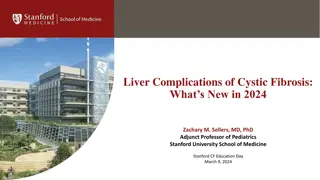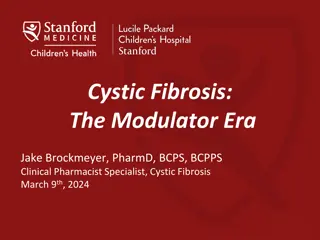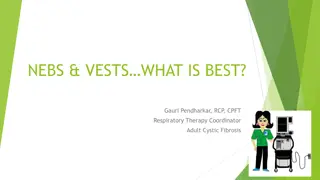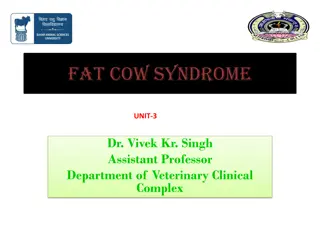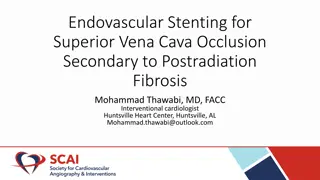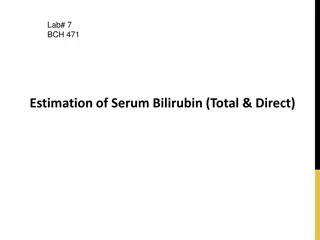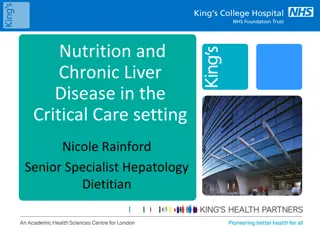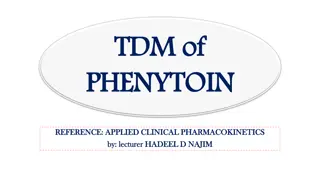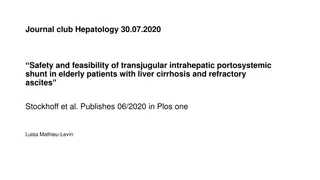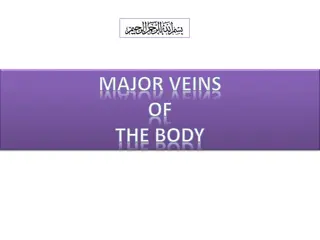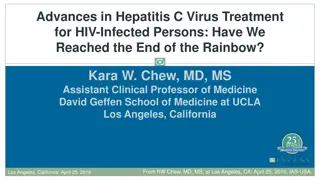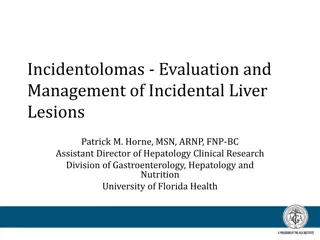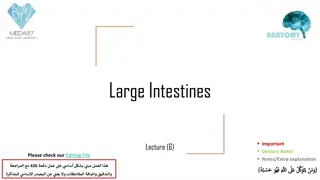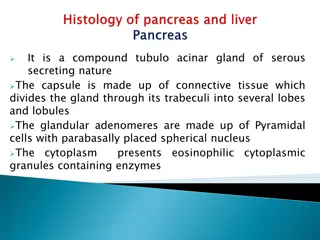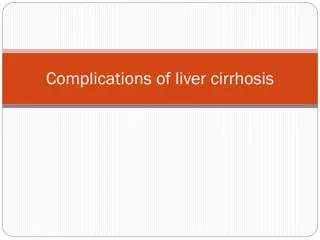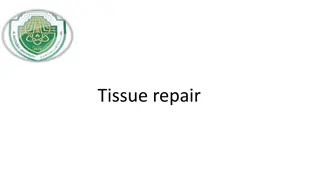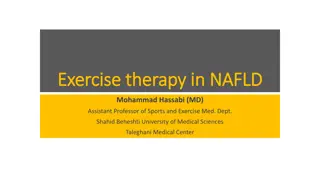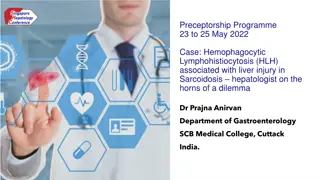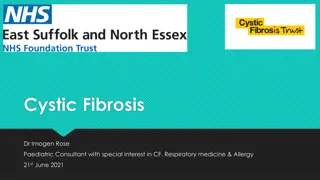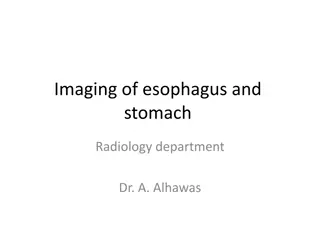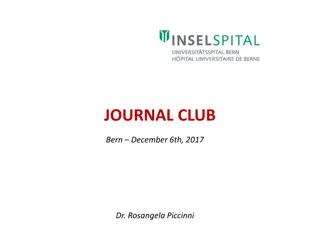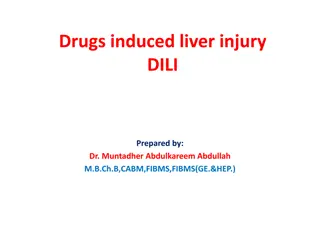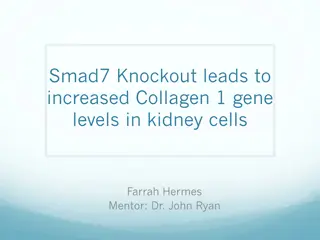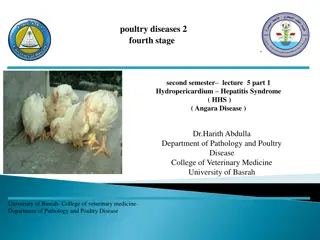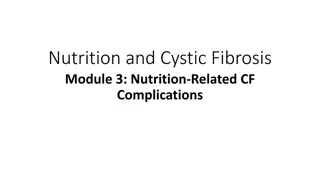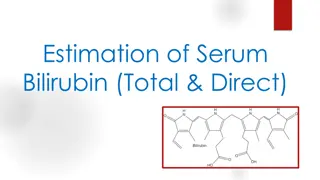RNA Interference Therapy Zilebesiran's Impact on Hypertension
Explore Zilebesiran, an investigational RNA interference therapeutic targeting hepatic AGT synthesis for hypertension. Primary findings from Phase 2 trial KARDIA-1 reveal sustained blood pressure reduction. Addressing the unmet need for innovative antihypertensive treatments.
0 views • 12 slides
Liver Transplant in India for treatment
Liver is the largest gland in our body, and an important metabolic organ which carries out many essential biological functions. The liver is a wedge-shaped, reddish-brown in color with two lobes of different size and shape. The approximate weight of a human liver is 1.5 kilograms. It is in the upper
5 views • 2 slides
Understanding Liver Complications in Cystic Fibrosis: Latest Insights for 2024
Liver complications in cystic fibrosis (CF) have gained importance due to CFTR modulators impacting liver health. This presentation by Dr. Zachary M. Sellers delves into new definitions for CF liver disease, CFF recommendations for screening, management, and treatment of hepatobiliary issues in CF.
0 views • 17 slides
Understanding Nontuberculous Mycobacteria Infections in Cystic Fibrosis
Nontuberculous mycobacteria (NTM) infections present a significant challenge in individuals with cystic fibrosis (CF). These infections are caused by over 200 species of atypical mycobacteria found in various environments. The CF-ID Clinic plays a crucial role in managing patients with multi-drug re
2 views • 25 slides
Cystic Fibrosis:The Modulator Era
Cystic Fibrosis (CF) is a genetic disease caused by variants in the CFTR gene. CFTR is a crucial membrane protein responsible for chloride transport in epithelial cells, impacting organ function. The Modulator Era focuses on CFTR modulators approved by the FDA for treating CF and improving outcomes.
0 views • 63 slides
Understanding Acetaminophen Poisoning: Mechanism, Toxicity, and Treatment
Acetaminophen poisoning occurs when the body is overwhelmed by high doses of the drug, leading to liver toxicity and potentially fatal consequences. The mechanism of toxicity involves the depletion of glutathione and the formation of a harmful metabolite, N-acetyl-para-benzoquinoneimine (NAPQI). Con
0 views • 9 slides
Overview of Human Genetic Disorders
Human genetic disorders encompass a range of conditions, from recessive disorders like cystic fibrosis to dominant disorders such as Huntington's disease. Examples include cystic fibrosis, Huntington's disease, and sickle-cell anemia. Understanding genetic disorders involves research and awareness o
0 views • 10 slides
Optimizing Respiratory Therapy for Adult Cystic Fibrosis Patients
Creating an effective daily respiratory therapy regimen is crucial for adults with Cystic Fibrosis (CF) to maintain healthy lungs and good lung function. This includes inhaled medications such as nebulizer treatments and bronchodilators, airway clearance techniques like the Vest and Pep devices, as
0 views • 32 slides
Understanding Fat Cow Syndrome in Cattle: Causes, Symptoms, and Treatment
Fat Cow Syndrome, also known as Fatty Liver Disease in Cattle, is a condition commonly seen in high-producing cows during the transition period around calving. The disease is characterized by mobilization of excessive body fat to the liver due to negative energy balance, leading to hepatic lipidosis
1 views • 10 slides
Endovascular Stenting for Superior Vena Cava Occlusion: A Case Study
Superior Vena Cava (SVC) occlusion secondary to postradiation fibrosis is a rare condition that can lead to debilitating symptoms. In this case study, a 47-year-old male with a history of Hodgkin lymphoma treated with chest radiotherapy presented with exertional chest pain and other associated sympt
1 views • 19 slides
Understanding Bilirubin: Estimation, Implications, and Causes of Jaundice
Bilirubin, a yellow compound in the catabolic pathway, plays a crucial role in health. Estimating serum bilirubin levels is key in diagnosing conditions like jaundice. Elevated levels, above 2 mg/dl, can indicate disease. Jaundice, characterized by skin and eye discoloration, has pre-hepatic, hepati
0 views • 16 slides
Nutritional Considerations for Chronic Liver Disease in Critical Care
Malnutrition is common in chronic liver disease, leading to complications such as ascites and infections. Sarcopenia and weight loss are prevalent regardless of BMI. Critical care patients with liver disease face challenges due to limited physiological reserve, with main causes for ICU admission bei
1 views • 17 slides
Understanding Nasopulmonary Drug Delivery System
Nasopulmonary drug delivery system, utilizing the nasal route for drug administration, offers advantages such as hepatic first-pass metabolism avoidance and rapid drug absorption. This system is beneficial for pharmacologically active compounds with poor stability in gastrointestinal fluids. While i
0 views • 35 slides
Understanding Phenytoin Therapy - Clinical Pharmacokinetics and Serum Concentrations
Phenytoin, a medication with high protein binding and hepatic metabolism, exhibits saturated pharmacokinetics with a narrow therapeutic range of 10-20 µg/mL for total serum concentrations. Adverse effects vary with serum levels: minor CNS depression at >15 µg/mL, nystagmus at >20 µg/mL, and ataxi
0 views • 55 slides
Safety and Feasibility of TIPS in Elderly Patients with Liver Cirrhosis
Challenging liver cirrhosis management in elderly patients with refractory ascites has high mortality rates, and transplantation is not always viable. Transjugular intrahepatic portosystemic shunt (TIPS) serves as a non-curative treatment option, aiming to reduce portal hypertension. The procedure i
0 views • 17 slides
Understanding Genetics: Part 2 - Cystic Fibrosis, Family Pedigrees, and Sex-Linked Genetic Disorders
Genetics is a fascinating field that influences our health and traits. Part 2 of our guide explores topics such as cystic fibrosis, family pedigrees, and sex-linked genetic disorders. Learn about the inheritance patterns, carrier statuses, and implications of these genetic conditions through detaile
0 views • 15 slides
Overview of Veins and Venous Circulation in the Body
Veins play a crucial role in the circulatory system by carrying deoxygenated blood back to the heart. This lecture covers the general principles of veins, the anatomy of major veins like the superior and inferior vena cavae, tributaries, and their roles in different parts of the body. It also discus
0 views • 14 slides
Advances in Hepatitis C Treatment for HIV-Infected Patients: A Comprehensive Overview
Explore the latest advancements in the treatment of Hepatitis C virus (HCV) in HIV-infected individuals through a detailed presentation by Dr. Kara W. Chew. Learn about the initial evaluation for HCV, treatment options for different genotypes, management of advanced fibrosis, recommended approaches
0 views • 9 slides
Evaluation and Management of Incidental Liver Lesions
Understanding the natural history, evaluation, and management of benign liver lesions is crucial for diagnosing incidental liver findings. Common benign liver lesions include hepatic hemangioma, focal nodular hyperplasia, hepatic adenoma, and hepatic cyst. Differential diagnosis plays a key role in
0 views • 37 slides
Understanding the Impact of Secondhand Smoke on Infants with Cystic Fibrosis
Studying infants with cystic fibrosis exposed to secondhand smoke revealed that those in smoke-free homes experienced better growth and lower risk of bacterial infections compared to those with smoking parents. Creating a quit plan for smokers is essential to improve health outcomes and prevent rela
2 views • 25 slides
Portal Vein Imaging Techniques and Anomalies Overview
Portal vein imaging is crucial for evaluating conditions affecting the abdominal part of the gastrointestinal tract. Techniques such as spleno-portography and CT triphasic contrast imaging are used to visualize the portal vein and diagnose anomalies like portal-systemic collaterals and porto-systemi
4 views • 7 slides
Understanding the Anatomy of the Large Intestine
The large intestine plays a crucial role in digestion. This comprehensive overview covers the different parts of the large intestine, characteristic features of the colon, anatomy details, peritoneal covering, relations with surrounding structures, arterial and nerve supply, and important flexures l
0 views • 13 slides
Structure and Function of a Serous Compound Tubulo-acinar Gland
A detailed description of a compound tubulo-acinar gland with serous-secreting nature is provided, highlighting its cellular composition, arrangement of ducts, and connective tissue organization. The glandular structure, including adenomeres, centroacinar cells, and myoepithelial cells, is discussed
0 views • 15 slides
Understanding Complications of Liver Cirrhosis
Recognize major complications of liver cirrhosis including hepatic failure, portal hypertension, ascites, hepatorenal syndrome, and esophageal varices. Learn about the pathogenetic mechanisms, clinical features, and pathological findings associated with these complications.
0 views • 30 slides
Understanding Complications of Liver Cirrhosis
Learn about the major complications of liver cirrhosis, including portal hypertension, hepatic failure, ascites, spontaneous bacterial peritonitis, and more. Explore the pathogenetic mechanisms, clinical features, and pathological findings associated with these complications, and understand the impa
0 views • 31 slides
Understanding Tissue Repair Mechanisms: Regeneration and Fibrosis
Tissue repair involves complex mechanisms like regeneration by parenchymal cells or fibrosis leading to scar formation. Inflammatory cells play a crucial role in tissue repair, along with processes like ECM synthesis and cell migration. Different types of cells in the body have varying regenerative
0 views • 20 slides
Understanding Tissue Repair: Regeneration and Fibrosis Mechanisms
Tissue repair involves two primary mechanisms: regeneration, where some tissues can replace damaged cells, and fibrosis, where scar tissue forms if regeneration is not possible. Cell proliferation, growth factors, and cell population control play key roles in the restoration of tissue architecture a
0 views • 15 slides
Benefits of Exercise Therapy in Nonalcoholic Fatty Liver Disease (NAFLD)
Exercise therapy plays a crucial role in managing nonalcoholic fatty liver disease (NAFLD) by improving hepatic aminotransferases and reducing steatosis. Lifestyle modifications, including increased physical activity, are essential in the treatment of NAFLD. This includes aerobic exercise, resistanc
0 views • 32 slides
Hemophagocytic Lymphohistiocytosis (HLH) and Sarcoidosis: A Complex Case Study
This case study delves into a challenging scenario where a hepatologist grapples with a patient presenting HLH associated with liver injury in the context of sarcoidosis. Despite inconclusive initial investigations, further work-up reveals indications of secondary HLH/MAS. The management involves a
0 views • 8 slides
Understanding Cystic Fibrosis: Causes, Symptoms, and Treatment Options
Cystic Fibrosis (CF) is a genetic condition affecting around 11,000 people in the UK. It disrupts salt and water movement in cells, leading to thicker, stickier mucus in the body. This condition can affect the lungs, digestive system, and pancreas, with symptoms such as chronic cough, digestive issu
0 views • 23 slides
Anatomy and Blood Supply of the Equine Stomach
The equine stomach is relatively small compared to the horse's body size, with distinct regions such as the cardia, fundus, body, and pyloric region. It is located on the left side of the abdomen, under the ribs. The stomach's blood supply includes branches from the aorta, splenic artery, and hepati
0 views • 23 slides
Radiology Imaging of Esophagus and Stomach by Dr. A. Alhawas
View detailed radiology imaging of the esophagus and stomach conducted by Dr. A. Alhawas, showcasing various anatomical structures such as the splenic artery, abdominal aorta, common hepatic artery, and more. Explore pathologically changed layers in pyloric stenosis, arterial blood supply to the pyl
0 views • 8 slides
Functional Anatomy and Blood Supply of the Liver
The liver is a crucial organ with dual functions and a complex anatomical structure. It consists of hepatic lobes and lobules, where hepatocytes play a vital role in various functions. The liver receives blood supply from both the hepatic artery and portal vein, allowing for essential processes such
0 views • 20 slides
Prediction of Liver Fibrosis in NAFLD Patients: Impact of CAP Values
Steatosis has emerged as a significant diagnosis with NAFLD becoming a common cause for hepatologic evaluation. Liver stiffness measurement (LSM) using transient elastography is vital for assessing fibrosis severity in NAFLD patients. However, the accuracy of LSM can be influenced by obesity and sev
0 views • 35 slides
Understanding Drug-Induced Liver Injury (DILI)
Drug-induced liver injury (DILI) can present as cholestasis, hepatocyte necrosis, steatosis, vascular damage, and hepatic fibrosis. Various drugs like antibiotics, NSAIDs, recreational drugs, and herbal remedies can cause liver damage. Recognizing DILI is crucial in patients with liver dysfunction o
0 views • 9 slides
Role of Smad7 Protein in Regulation of Collagen 1 Gene in Kidney Cells
Smad7 knockout leads to increased Collagen 1 gene levels in kidney cells, potentially contributing to renal fibrosis. Lack of Smad7 protein may result in overproduction of Collagen 1. This protein is found in the extracellular matrix and plays a crucial role in kidney fibrosis pathways, such as TGF-
0 views • 12 slides
Hydropericardium Hepatitis Syndrome (HHS) in Poultry: Causes, Symptoms, and Prevention
HHS is an acute infectious disease in chickens characterized by high morbidity and mortality, excess pericardial fluid, and multifocal hepatic necrosis. It mainly affects broilers and broiler parents, with clinical signs such as sudden mortality, lethargy, and ruffled feathers. Post-mortem lesions i
0 views • 6 slides
Nutrition and Cystic Fibrosis: Management of CF-Related Complications
Explore the nutrition implications and management strategies for CF-related liver disease, gastrointestinal complications, and CF-related diabetes in patients. Learn about the proposed mechanisms, prevalence rates, and consequences of hepatic complications in cystic fibrosis. Gain insights into neon
0 views • 23 slides
Understanding Serum Bilirubin: Types, Estimation, and Causes of Jaundice
Serum bilirubin levels are crucial in diagnosing conditions like jaundice, with total, direct, and indirect bilirubin playing key roles. Excess bilirubin in the blood can lead to jaundice, characterized by yellow discoloration of the skin and eyes. Different types of jaundice, including pre-hepatic,
0 views • 14 slides
Stanford Adult Cystic Fibrosis Patient Advisory Council Initiatives
The Stanford Adult CF PFAC works to enhance patient and family experiences at Stanford Health Care's Cystic Fibrosis Center. Initiatives include establishing a memorial space, exploring home FEV1 monitoring, capturing patient encounters for teaching, and collaborating with the CFF for clinic develop
0 views • 11 slides


